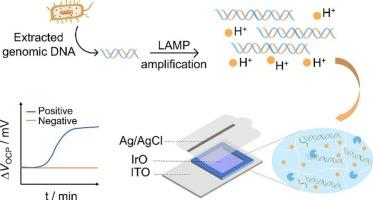Label-free detection of Vibrio parahaemolyticus using a solid-state pH sensor
IF 4.1
3区 化学
Q1 CHEMISTRY, ANALYTICAL
引用次数: 0
Abstract
Vibrio parahaemolyticus is a prevalent foodborne pathogen which can cause acute gastroenteritis, septicemia and even death. Therefore, rapid and accurate detection of Vibrio parahaemolyticus is of critical importance for ensuring food safety and public health. Herein, we report the development of a pH-ultrasensitive electrochemical sensor based on iridium oxide (IrO) for the real-time and label-free detection of Vibrio parahaemolyticus. The IrO was electrodeposited on the indium tin oxide (ITO) electrode using a silica nanochannel membrane as the template. The obtained IrO/ITO electrode functions as a solid-state pH sensor and displays a super-Nernstian response with a sensitivity over 78 mV/pH, enabling the effective detection of hydrogen ions released by hydrogel-based loop-mediated isothermal amplification (LAMP) and realizing the quantification of Vibrio parahaemolyticus. Owing to the confinement effect of the unique porous structure of hydrogel, the efficiency of LAMP reaction is significantly promoted, thus achieving the rapid detection of Vibrio parahaemolyticus within 30 min with a detection limit as low as 1.93 copies/reaction. Furthermore, the electrochemical sensor is fully sealed and free of aerosol contamination. We believe that the sensor can be potentially employed for the detection of other pathogens and in point-of-care testing diagnostics.

固体pH传感器对副溶血性弧菌的无标记检测
副溶血性弧菌是一种流行的食源性病原体,可引起急性胃肠炎、败血症甚至死亡。因此,快速准确地检测副溶血性弧菌对保障食品安全和公众健康至关重要。在此,我们报道了一种基于氧化铱(IrO)的ph超灵敏电化学传感器的开发,用于实时和无标记检测副溶血性弧菌。以二氧化硅纳米通道膜为模板,在氧化铟锡(ITO)电极上电沉积了IrO。所制备的IrO/ITO电极作为固态pH传感器,具有超nernstian响应,灵敏度超过78 mV/pH,能够有效检测水凝胶基环介导等温扩增(LAMP)释放的氢离子,实现副溶血性弧菌的定量。由于水凝胶独特的多孔结构的约束作用,大大提高了LAMP反应的效率,从而实现了30 min内快速检测副溶血性弧菌,检出限低至1.93 copies/reaction。此外,电化学传感器是完全密封的,没有气溶胶污染。我们相信,传感器可以潜在地用于检测其他病原体和在点护理测试诊断。
本文章由计算机程序翻译,如有差异,请以英文原文为准。
求助全文
约1分钟内获得全文
求助全文
来源期刊
CiteScore
7.80
自引率
6.70%
发文量
912
审稿时长
2.4 months
期刊介绍:
The Journal of Electroanalytical Chemistry is the foremost international journal devoted to the interdisciplinary subject of electrochemistry in all its aspects, theoretical as well as applied.
Electrochemistry is a wide ranging area that is in a state of continuous evolution. Rather than compiling a long list of topics covered by the Journal, the editors would like to draw particular attention to the key issues of novelty, topicality and quality. Papers should present new and interesting electrochemical science in a way that is accessible to the reader. The presentation and discussion should be at a level that is consistent with the international status of the Journal. Reports describing the application of well-established techniques to problems that are essentially technical will not be accepted. Similarly, papers that report observations but fail to provide adequate interpretation will be rejected by the Editors. Papers dealing with technical electrochemistry should be submitted to other specialist journals unless the authors can show that their work provides substantially new insights into electrochemical processes.

 求助内容:
求助内容: 应助结果提醒方式:
应助结果提醒方式:


